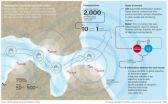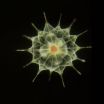(Press-News.org) Biodiversity decreases towards the poles almost everywhere in the world, except along the South American Pacific coast. Investigating fossil clams and snails Steffen Kiel and Sven Nielsen at the Christian-Albrechts-Universität zu Kiel (CAU) could show that this unusual pattern originated at the end of the last ice age, 20.000 to 100.000 years ago. The retreating glaciers created a mosaic landscape of countless islands, bays and fiords in which new species developed rapidly – geologically speaking. The ancestors of the species survived the ice age in the warmer Chilean north.
The exceptional biodiversity of the southern Chilean coast is known for a long time. More than 500 species of clams and snails are known from this area, twice as many as at comparable latitudes in the northern hemisphere. The reasons for this diversity were so far speculative, report Kiel and Nielsen in the current issue of the scientific journal Geology: "Opinions include that southern Chile is a museum of diversity where species survived for millions of years in addition to new arrivals; or that Antarctic species colonized this area from the south." Their analysis of around 35.000 fossil clams and snails, belonging to about 400 species, allowed the paleontologists to draw some more precise conclusions: "Our fossils reject both hypotheses. Biodiversity in this area always decreased toward the south in the geologic past, and we didn't find any intruders from Antarctica", explains Steffen Kiel. In addition, the researchers found that the vast majority of species and genera that lived in that area only 16 million years ago had become extinct. "This area is certainly not a museum of biodiversity", adds Kiel.
The most species-rich groups of animals in the southern Chilean fiordlands are those inhabiting rocky shores. This is exactly the habitat that was created when the glacier retreated from their marine termini. "Molecular biologic investigations on phylogenetic relationships of these species show that they are geologically very young and descended from North Chilean ancestors. This agrees well with our results", says Sven Nielsen, who has been working on Chilean fossils for many years. "Charles Darwin, who was the first to discover fossils in this area during his voyage on the 'Beagle', would have been fascinated."
This research shows that for species conservation not only single, exceptional habitats need to be protected, but that a diversity of habitats needs be conserved to maintain a healthy biodiversity.
INFORMATION:
Link:
http://geology.gsapubs.org/content/38/10/955.abstract
Images:
http://www.uni-kiel.de/download/pm/2010/2010-152-1.jpg
Caption: Sven Nielsen takes an inventory of early biodiversity.
Photo/Copyright: Matthias Rosenau/GFZ Potsdam
http://www.uni-kiel.de/download/pm/2010/2010-152-2.jpg
Caption: Fossil Chilean clams and snails.
Photo/Copyright: Sven Nielsen
http://www.uni-kiel.de/download/pm/2010/2010-152-3.jpg
Caption: The diversity of clams and snails had been higher in earlier times.
Photo/Copyright: Sven Nielsen
http://www.uni-kiel.de/download/pm/2010/2010-152-4.jpg
Caption: Fossils from these bluffs at Cucao in southern Chile revealed insights into the exceptional history of biodiversity in this area.
Photo/Copyright: Sven Nielsen
Contact:
Dr. Sven Nielsen
E-Mail: nielsen@gpi.uni-kiel.de
Tel. +49(0)431/880-2862
Dr. Steffen Kiel
E-Mail: steffen.kiel@gmx.de
Tel: +49(0)551/3910954
Disappearing glaciers enhanced biodiversity
Fossils reveal history of marine diversity in Chile
2010-10-05
ELSE PRESS RELEASES FROM THIS DATE:
A step toward lead-free electronics
2010-10-05
Research published today by materials engineers from the University of Leeds could help pave the way towards 100% lead-free electronics.
The work, carried out at the UK's synchrotron facility, Diamond Light Source, reveals the potential of a new manmade material to replace lead-based ceramics in countless electronic devices, ranging from inkjet printers and digital cameras to hospital ultrasound scanners and diesel fuel injectors.
European regulations now bar the use of most lead-containing materials in electronic and electrical devices. Ceramic crystals known as 'piezoelectrics' ...
Ancient Colorado river flowed backwards
2010-10-05
Palo Alto, CA—Geologists have found evidence that some 55 million years ago a river as big as the modern Colorado flowed through Arizona into Utah in the opposite direction from the present-day river. Writing in the October issue of the journal Geology, they have named this ancient northeastward-flowing river the California River, after its inferred source in the Mojave region of southern California.
Lead author Steven Davis, a post-doctoral researcher in the Department of Global Ecology at the Carnegie Institution, and his colleagues* discovered the ancient river system ...
An eye for an eye
2010-10-05
Revenge cuts both ways in the Israeli-Palestinian conflict. Scientists of the University of Zurich, the Massachusetts Institute of Technology, and Tel Aviv and Quinnipiaq Universities show that attacks by either side lead to violent retaliation from the other. Both Israelis and Palestinians may underestimate their own role in perpetuating the conflict.
A team of scientists from the University of Zurich, the Massachusetts Institute of Technology, and Tel Aviv and Quinnipiaq Universities have found that attacks by both Israel and Palestinians lead to violent retaliation ...
When docs counsel weight loss, it's style that makes a difference
2010-10-05
DURHAM, N.C. – Most doctors are spending a good deal of time counseling their patients about diet and weight loss, but for the most part, it isn't making any difference, according to a new study appearing in the American Journal of Preventive Medicine.
Duke University Medical Center researchers recorded the conversations between 40 primary care physicians and 461 of their overweight or obese patients over an 18-month period. Investigators didn't tell them what they were listening for – only that they wanted to record the encounters to see how doctors talked about health. ...
Researchers find possible biomarker to identify seizure-related stress
2010-10-05
PROVIDENCE, RI -- New research from Rhode Island Hospital found that reduced levels of brain-derived neurotrophic factor (BDNF), a protein in the brain that encourages growth of neurons, may be a trait marker for individuals with psychogenic non-epileptic seizures (PNES) (seizures that are psychological in origin). The findings are published in the October 4, 2010, issue of Neurology, the medical journal of the American Academy of Neurology.
Past studies have shown decreased levels of BDNF in the serum of patients with psychiatric disorders such as major depressive disorder ...
An intelligent system for maritime surveillance has been created
2010-10-05
The system has been designed by scientists from this Madrid university for Núcleo CC, a company which develops surveillance systems for the maritime and aeronautic sectors. The first prototype will be used in the near future in Cape Verde (Africa). Two types of sensors have been deployed there: a set of radars and a series of AIS (Automatic Identification System), which allow ships to communicate their position and give other relevant data on their location and characteristics. These two types of sensors offer complementary data which can be fused in order to obtain better ...
MBL scientists reveal findings of World Ocean Microbe Census
2010-10-05
LONDON, UK—After a decade of joint work and scientific adventure, marine explorers from more than 80 countries, including six scientists from the Marine Biological Laboratory (MBL), today delivered the first global Census of Marine Life revealing what, where, and how much lives and hides in the world's oceans. In one of the largest scientific collaborations ever conducted, more than 2,700 scientists spent over 9,000 days at sea on more than 540 expeditions gathering the data.
As a result of these efforts the scientists discovered that there may be up to 1 billion kinds ...
New report examines university management of intellectual property
2010-10-05
WASHINGTON — The system put in place by the Bayh-Dole Act of 1980 -- which gives universities significant control over intellectual property associated with the results of federally funded research at their institutions – has been more effective than the pre-1980 system in making research advances available to the public and spurring innovation, says a new report from the National Research Council. Nevertheless, the current system needs improvement, said the committee that wrote the report.
"The public investment in research universities has led to a great deal of new ...
Surprise: Scientists discover that inflammation helps to heal wounds
2010-10-05
A new research study published in The FASEB Journal (http://www.fasebj.org) may change how sports injuries involving muscle tissue are treated, as well as how much patient monitoring is necessary when potent anti-inflammatory drugs are prescribed for a long time. That's because the study shows for the first time that inflammation actually helps to heal damaged muscle tissue, turning conventional wisdom on its head that inflammation must be largely controlled to encourage healing. These findings could lead to new therapies for acute muscle injuries caused by trauma, chemicals, ...
Technology transfer and postdoc entrepreneurs
2010-10-05
Post-doctoral researchers see their role as being vital in technology transfer where scientific findings become useful to the local economy, but most have little interest in running their own business once their research fellowship ends. That's the surprising finding of a study published in the International Journal of Knowledge-Based Development.
Edmund Zolnik, a public policy specialist at the George Mason University, in Arlington, Virginia, has surveyed postdoctoral fellows in the US National Capital Region. He found that most saw technology transfer as an important ...
LAST 30 PRESS RELEASES:
Interaction of climate change and human activity and its impact on plant diversity in Qinghai-Tibet plateau
From addressing uncertainty to national strategy: an interpretation of Professor Lim Siong Guan’s views
Clinical trials on AI language model use in digestive healthcare
Scientists improve robotic visual–inertial trajectory localization accuracy using cross-modal interaction and selection techniques
Correlation between cancer cachexia and immune-related adverse events in HCC
Human adipose tissue: a new source for functional organoids
Metro lines double as freight highways during off-peak hours, Beijing study shows
Biomedical functions and applications of nanomaterials in tumor diagnosis and treatment: perspectives from ophthalmic oncology
3D imaging unveils how passivation improves perovskite solar cell performance
Enriching framework Al sites in 8-membered rings of Cu-SSZ-39 zeolite to enhance low-temperature ammonia selective catalytic reduction performance
AI-powered RNA drug development: a new frontier in therapeutics
Decoupling the HOR enhancement on PtRu: Dynamically matching interfacial water to reaction coordinates
Sulfur isn’t poisonous when it synergistically acts with phosphine in olefins hydroformylation
URI researchers uncover molecular mechanisms behind speciation in corals
Chitin based carbon aerogel offers a cleaner way to store thermal energy
Tracing hidden sources of nitrate pollution in rapidly changing rural urban landscapes
Viruses on plastic pollution may quietly accelerate the spread of antibiotic resistance
Three UH Rainbow Babies & Children’s faculty elected to prestigious American Pediatric Society
Tunnel resilience models unveiled to aid post-earthquake recovery
Satellite communication systems: the future of 5G/6G connectivity
Space computing power networks: a new frontier for satellite technologies
Experiments advance potential of protein that makes hydrogen sulfide as a therapeutic target for Alzheimer’s disease
Examining private equity’s role in fertility care
Current Molecular Pharmacology achieves a landmark: real-time CiteScore advances to 7.2
Skeletal muscle epigenetic clocks developed using postmortem tissue from an Asian population
Estimating unemployment rates with social media data
Climate policies can backfire by eroding “green” values, study finds
Too much screen time too soon? A*STAR study links infant screen exposure to brain changes and teen anxiety
Global psychiatry mourns Professor Dan Stein, visionary who transformed mental health science across Africa and beyond
KIST develops eco-friendly palladium recovery technology to safeguard resource security
[Press-News.org] Disappearing glaciers enhanced biodiversityFossils reveal history of marine diversity in Chile


